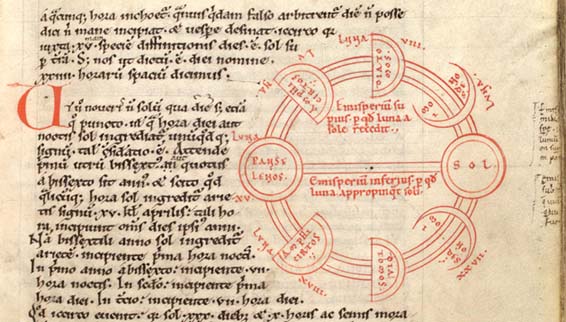| Please note that these pages are from our old (pre-2010) website; the presentation of these pages may now appear outdated and may not always comply with current accessibility guidelines. |
| Please note that these pages are from our old (pre-2010) website; the presentation of these pages may now appear outdated and may not always comply with current accessibility guidelines. |

| This vellum manuscript is a compilation of several works mainly concerning the use of the Calendar, by the Venerable Bede, Abbo of Fleury, Hyginus, and others. The manuscript was written in Durham by a number of scribes during the second quarter of the twelfth century. |
|
folio 2v: left hand page of Calendar |

folio 3r: right hand page of Calendar |
|
The first pages consist of a Roman Calendar decorated with 'clove-curl' ornaments in red, green and blue. This is followed by Bede's 19 Year Cycles, covering the years 1-1253 A.D. Bede's greatest scientific achievement was the creation of the western calendar, based upon the tables which had originally been conceived by the sixth century Egyptian Dionysius Exiguus. These tables were designed to be used in calculating the date of Easter according to a 19 year lunar cycle, after which cycle the same Easter dates would occur. It was this way of calculating Easter which was chosen at the synod of Whitby in 664, rejecting the rival method of the Iona Church and thereby bringing the Northumbrian Church into line with the rest of Europe. Bede adopted and authorised the Dionysian method and added 'Anno Domini' dates to it; thus, not only did he define for the future the Church's method for the calculation of Easter, but he also played a major part in establishing 'AD' as the normal system for dating in Europe. The tables are accompanied here by a brief chronicle in the margin. |
|
folio 24r: 19 year cycles, including chronicle entry for 1001 |
| Born in about 673, Bede was placed under the care of Benedict Biscop, Abbot of Wearmouth, at the age of seven. A few years later he was sent to the foundation of Jarrow under Abbot Ceolfrid and there he remained, learning, teaching and writing for the rest of his life. He is famous for writing the History of the English Church and People which earned him the title the 'Father of English History'. However, as well as historical and biographical works, he also wrote scriptural commentaries and treatises on grammar and science. The major work of this manuscript is Bede's treatise of 725 On the Reckoning of Time. Amplifying his earlier work On Times, the book was intended to provide Bede's students with a theoretical outline to increase their understanding of computation and the calendar. |
|
|
The text is introduced by an initial 'd' in red, green, blue, yellow and
purple. It contains a seated representation of the author, identified by the
inscription 'S. BEDA. P[resbiter]' . The opening words of the preface De
natura rerum et ratione temporum... appear on the scroll he holds. The
codex form had replaced the scroll some centuries before Bede was writing,
but here the scroll has been used to confer an authoritative sense of
antiquity and to provide a larger space for the words than an open book
would have done Starting with the smallest units of time, the text describes days, weeks and months before proceeding on to lunar movements and the seasons; solar movements and years are then treated. The different lengths of days and nights and the variation of shadow lengths cast on the earth's surface at different times during the year are explained. Bede simply states that the reason for the unequal length of days is due to the globular shape of the earth, thus explaining the three-dimensional nature of the earth and refuting the notion that early medieval people believed that the earth was flat. The work moves on to the larger units of time, the Six Ages of the world. It ends with a discussion of eternity (the greatest unit of time) which man meets in the Eighth Age. The work thus finishes in sublime devotion; of course, for Bede, computation was a necessary elementary discipline leading to the greater understanding of the scriptures. |
 folio 53r: diagram from On the reckoning of time |
|
||||||
| The present Cathedral in Durham was planned and begun by Bishop Carileph (1081-1096) on the site of the earlier Saxon 'White Church', to be both a magnificent shrine for the body of St Cuthbert and also a home for a community of Benedictine monks. |
 folio 118r: diagram from Abbo's Opinion concerning the System of the Sphere |
| By the end of the sixteenth century, manuscripts at Durham were described by Robert Heffe as being abandoned to the bats and pigeons: antiquarians such as Sir Robert Cotton apparently helped themselves to these treasures. Although originally part of William Hunter's collection, this manuscript was not actually bequeathed to Glasgow University along with his other books. It was purchased on behalf of the Hunterian Museum by William Turner from a Mr Taylor in November 1810 for £3.3s. Mr Taylor had acquired the manuscript as composition for a debt from Matthew Baillie. |
Other items of interestOther Bede related manuscripts: Scintillae or Loci Communes 12th century MS Hunter 30 (S.2.20: item 1); Commentary on the Acts 12th or 13th century MS Hunter 438 (V.5.8: item 1); Explanation of Place-Names in the Acts (V.5.8: item 2); Reactions on the Acts (V.5.8: item 3); Commentary on the Catholic Epistles Late 12th century MS Hunter 446 (V.5.16); Ecclesiastical History 1515 MS Hunter 86 (T.4.3) Bede related early printed books: De natura rerum & De temporum
ratione Basle: 1529
Sp Coll
Eadie f1; Reportium siue tabula gereralis auctoritatum Aristotelis cum
commento per modum alphabeti et philosophorum. Nuremberg: 1490
Sp Coll
BC2-f.6 Return to main Special Collections Exhibition Page Julie Coleman January 2001
|